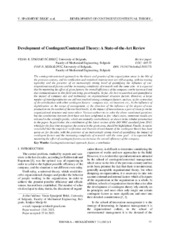Приказ основних података о документу
Development of Contingent/Contextual Theory: A State-of-the-Art Review
| dc.creator | Spasojević Brkić, Vesna | |
| dc.creator | Mihajlović, Ivan | |
| dc.date.accessioned | 2023-03-11T17:20:15Z | |
| dc.date.available | 2023-03-11T17:20:15Z | |
| dc.date.issued | 2023 | |
| dc.identifier.issn | 0040-2176 | |
| dc.identifier.uri | https://machinery.mas.bg.ac.rs/handle/123456789/5823 | |
| dc.description.abstract | The contingent/contextual approach to the theory and practice of the organization arose in the 60s of the previous century, and its verification and empirical improvement are still ongoing, with increasing topicality and the presence of an increasingly strong trend of quantifying the influence of contingent/contextual factors and the increasing complexity of research with the same aim - it is expected that by mastering the effect of given factors, the overall efficiency of the company can be increased and that standardization in this field can bring great benefits. So far, the best researched and quantified is the impact of company size and technology on organizational structure factors. However, a large number of interdependencies are still not resolved among contingent factors, such as: a) the connection of decentralization with other contingent factors - company size, environment, etc., b) the influence of digitalization on the range of management, c) the direction of the influence of the degree of mass production on the number of hierarchical levels, d) the impact of innovation as a part of strategy on the organizational structure and many others. Various authors try to solve the above-mentioned questions, but the conclusions between them have not been confirmed so far; what's more, numerous results are released to the scientific public, which are mutually contradictory, as shown in the tabular presentation in the paper. In particular, the contribution of the latest version of the ISO 9001 standard from 2015, which for the first time recognizes the context in the given area, should be highlighted. Finally, it can be concluded that the empirical verification and theoretical enrichment of the contingent theory has been going on for decades, with the presence of an increasingly strong trend of quantifying the impact of contingent factors and the increasing complexity of research with the same goal - it is expected that mastering the effect of contingent factors can increase the overall efficiency of the company. | sr |
| dc.language.iso | en | sr |
| dc.publisher | Beograd : Savez inženjera i tehničara Srbije | sr |
| dc.rights | openAccess | sr |
| dc.rights.uri | https://creativecommons.org/licenses/by/4.0/ | |
| dc.source | Tehnika | sr |
| dc.subject | Contingent/contextual approach, factor, contribution. | sr |
| dc.subject | Contingent/contextual approach | sr |
| dc.subject | factor | sr |
| dc.subject | contribution | sr |
| dc.title | Development of Contingent/Contextual Theory: A State-of-the-Art Review | sr |
| dc.type | article | sr |
| dc.rights.license | BY | sr |
| dc.rights.holder | Savez inženjera i tehničara Srbije, Beograd | sr |
| dc.citation.epage | 88 | |
| dc.citation.issue | 1 | |
| dc.citation.rank | M53 | |
| dc.citation.spage | 77 | |
| dc.citation.volume | 78 | |
| dc.identifier.doi | 10.5937/tehnika2301077S | |
| dc.identifier.fulltext | http://machinery.mas.bg.ac.rs/bitstream/id/14306/docs3192.pdf | |
| dc.type.version | publishedVersion | sr |


